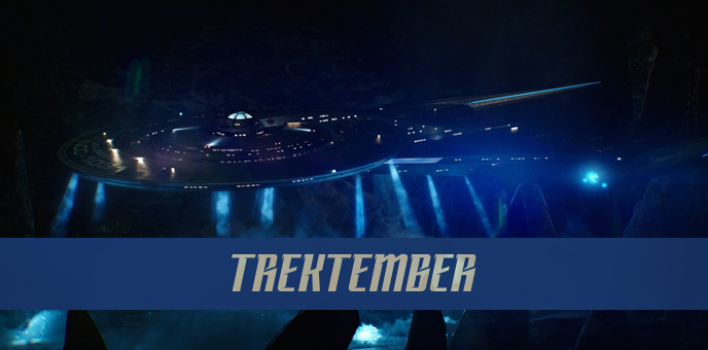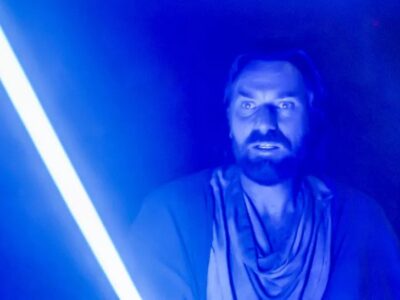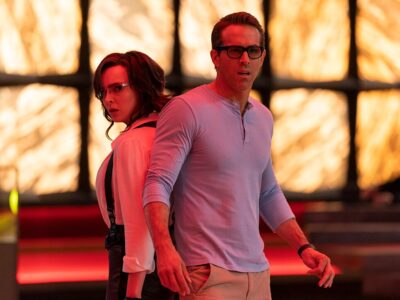Trektember: Will You Take My Hand? | Star Trek: Discovery
The season finale to the first season of Star Trek: Discovery draws upon the depth of the entire season to deliver a show full of fanservice, callbacks, and worldbuilding in service of a uniquely Star Trek story. Of course, that means that I’m about to spoil not only this episode but the entire series. You’ve been warned.
The Bat’leth of Damocles
Starfleet, facing near-extinction at the point of a Klingon bat’leth, sends Discovery on a hail-mary mission to Qo’noS, the Klingon homeworld. Under the command of mirror-universe Georgiou, the ship makes a spore jump to a cavern inside the planet. On the surface, the away team (Georgiou, Burnham, Tyler, and Tilly) searches for the remains of a now-dormant volcanic network that will allow a drone to map the planet.
Only, as Tilly discovers, the volcanic network is not dormant—and the drone is not a drone. Instead, Starfleet has worked with mirror-Georgiou to concoct a secret plan to destroy the Klingon homeworld with a devastating bomb. Burnham stands up to Admiral Cornwell, reminding her of the Federation’s deepest principles, and gets the go-ahead to confront Georgiou directly. Taking the bomb’s detonator from her, Burnham transfers it to L’Rell in hopes that she can unify the houses of the Klingon Empire.
In the lengthy denouement, Burnham is restored to the rank of Commander, the rest of the crew is promoted, mirror-Georgiou vanishes into the galactic underworld, and L’Rell begins her attempt at the unification she promised.
The episode is filled with beautiful worldbuilding. We’ve been on the Klingon homeworld before, but this show elevates the mythology of both the Klingon underworld and the Orion people by mating them together. That said, Akiva Goldsman’s intercutting during the medal sequence is jarring and breaks immersion. The show’s staunch and slavish dedication to the 45-minute episode length, instead of taking advantage of its digital distribution to let the story breathe, was likewise a painfully missed opportunity.
Still, Sonequa Martin-Green turns in one of her most believable performances all season: going toe-to-toe with Jayne Brook to defend Federation ideals, head-to-head with Michelle Yeoh to defend Klingon lives, and heart-to-heart with Shazad Latif to defend their relationship. She never misses a beat, and the cast surrounding her is up to her challenge: Doug Jones, though relegated to a supporting role in this episode, remains a commanding presence as Saru throughout; Mary Wiseman switches adroitly between neurotic and terrifying on the surface of Qo’noS; and Mary Chieffo walks a fine line between the classical Klingon and a new kind of honor.
And the finale, while not entirely free of plot holes, is clever, satisfying, and uniquely Trek-y: in the face of the question to destroy or be destroyed, Burnham elects neither, finding instead the peace that the rest of the Federation has been unable to find for a year. And in so doing, she manages to let the Federation keep its soul.
The General and the Young Soldier
At first glance, the episode appears to be about fear. Burnham’s speech bookending the episode relays a legend about a general, counseling a fresh soldier how to deal with fear. The speech points us toward themes of fear and how we deal with it, themes already more deeply explored earlier, in “Si Vis Pacem, Para Bellum.”
But the show does some clever narrative work to flip the intention of that story about halfway through: at the beginning, the speech seems to be aimed at the fresh-faced crew of the Discovery, with Burnham playing the role of the general in the story; and at the end, the speech is pointed squarely at Federation leadership, reminding them what the Federation really is.
And that’s what this episode is really about: it’s about what Burnham has learned in her last year, as she’s been turned upside down and inside out by the Klingons, two evil Captains, a con man, and herself: Who you are in times of crisis is who you really are.
The Luxury of Principles
Burnham: “But ask yourself: why did you put this mission in the hands of a Terran, and why the secrecy? It’s because you know it’s not who we are.”
Cornwell: “It very soon will be. We do not have the luxury of principles.”
Burnham: “It is all we have!”
The first season of Star Trek: Discovery is bookended with Burnham’s mutinies. This mutiny redeems her from the one in “The Vulcan Hello;” it proves that she sees the error of her actions.
The way we react in crisis displays who we really are: in “The Vulcan Hello” Burnham displayed that she was really a fearful person. In “Will You Take My Hand?” Cornwell showed that the Federation had become fearful, acting like Burnham had done a year prior. They’re losing their identity, peace being replaced with fear. “A year ago, I stood alone,” Burnham recalls by way of comparison; “I believed that our survival was more important than our principles. I was wrong. Do we need a mutiny today to prove who we are?”
And that identity part is important, because it’s easy to be the Federation when you’re not at war or on the brink of destruction. It’s easy to stick to your principles when they’re not the thing that might lead to your annihilation. It’s easy to be noble when there are no consequences.
It certainly is for me, at least. And it was for Peter, who talked a big game in Matthew 26: “Though they all fall away because of you, I will never fall away,” he tells Jesus in verses 30-35; “Even if I must die with you, I will not deny you!”
And then the bottom drops out of Peter’s life. If he were living this season of Star Trek: Discovery, the next 35 verses would be him losing a war with the Klingons, seeing no hope, and losing faith. Because in verse 70, he tells a servant girl who asks if he knows Jesus, “I do not know what you mean.”
When I was a kid, well-meaning preachers and youth leaders used this story to encourage us toward evangelism. “Don’t be afraid to tell a servant girl about Jesus!” they would admonish us; but it’s not just Peter abandoning his evangelism. He’s abandoning his principles, surprisingly quickly after laying them down in the first place, because he’s afraid he’ll be found out and will share Jesus’ fate.
It tears Peter up inside when he realizes what he’s done, and he won’t be fully restored until Jesus Himself comforts him in John 21.
Peter and Burnham both discover firsthand that sacrificing who we are to survive merely kills us more quietly; instead of a struggle and a fight lost with honor and dignity, we merely surrender and walk silently into darkness.
Leading in Crisis
The story of Peter’s failure isn’t the end any more than the story of Cornwell’s failure is. Good news for us, because we’re going to fail, too. We won’t live up to our principles and identity. We’ll give in to fear and cede control of our lives to an evil being from a terrifying place.
In Cornwell’s case, she’s saved from terrible consequences of her failure because Burnham puts her life on the line to stop Georgiou; rescuing both the Klingons and the soul of the Federation at the same time. And in Peter’s case, he’s saved from his failure by an understanding Jesus.
Jesus proves His identity in the garden of Gethsemane. In crisis, he turns to God in prayer:
And going a little farther, he fell on the ground and prayed that, if it were possible, the hour might pass from him. And he said, “Abba, Father, all things are possible for you. Remove this cup from me. Yet not what I will, but what you will.”
—Mark 14:35-36, ESV
Jesus’ identity is God’s son, even in crisis. Maybe especially in crisis. And at his darkest moment, He nevertheless sought to do God’s will.
So He went to the cross, and died for Peter’s failure; and for yours and mine. He lived up to His principles and identity so that when you don’t live up to yours, when you’re not like Jesus, you can still be saved.
We talk a lot in culture-redeeming circles about “Christ figures:” characters in fiction who show what Christ is like, in incomplete but real ways. Most of the time, Christ figures are considered such because they put their lives on the line to save another, or die to protect an idea. It’s rare to see a Christ figure (like Burnham) put their life on the line to keep someone else from betraying their identity.
But it shouldn’t surprise us. Jesus did that too.
• • •
Trektember is an annual series about Star Trek; this year, we’re examining the first seasons of Star Trek: Discovery and The Orville. And this is the final episode! For more information on this series, click here; or, to read every article from the beginning, click here!








Pingback: Trektember: Season 3 Wrap-Up | Reel World Theology